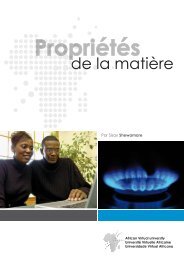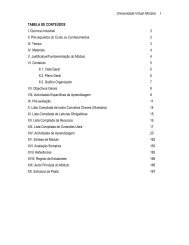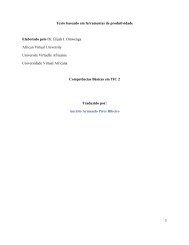Physical Chemistry 2.pdf - OER@AVU - African Virtual University
Physical Chemistry 2.pdf - OER@AVU - African Virtual University
Physical Chemistry 2.pdf - OER@AVU - African Virtual University
Create successful ePaper yourself
Turn your PDF publications into a flip-book with our unique Google optimized e-Paper software.
Interactive exercise: Vapour pressure<br />
<strong>African</strong> <strong>Virtual</strong> <strong>University</strong><br />
An ideal solution is a solution in which the forces of intermolecular attraction in<br />
the two components (solute and solvent) are very similar to one another and to the<br />
forces of attraction (solvent-solute) in the solution. Ideal solutions are therefore ones<br />
for which the enthalpy of solution is zero. In other words they occur when solute<br />
and solvent are very similar-for example, benzene and toluene; hexane and heptane;<br />
pentanol and hexanol. If the forces of attraction differ in the two components and<br />
the solution, the solution is said to deviate from Raoult’s law. Real solutions follow<br />
a different law known as Henry’s law. William Henry found that the vapour pressure<br />
of a dilute solution is proportional to the mole fraction, x B .<br />
P B = x B K B Henry's law (1.23)<br />
The proportionality constant K B has pressure units and is unique for to each gas.<br />
Henry’s law constant depends on temperature and the solvent/solute combination.<br />
1.9 Colligative Properties<br />
Colligative properties are solution properties dependent only on the amount of solute<br />
present. The particles in solutions may be ions or molecules. Colligative properties<br />
include vapour pressure, boiling point, melting point and osmotic pressure. In the<br />
section that follows we examine the effects of solutes on a liquid on the properties<br />
just mentioned.<br />
Vapour pressure of solutions<br />
(a) (b)<br />
F ig ure 1.8 (a) Liquid-vapour<br />
equilibrium with a relati vely rate of<br />
vap orisat ion (b) Some solvent<br />
molecules have b een replaced with<br />
solute molecules. T he rate at which<br />
solvent molecules are escaping is<br />
lower. Low rate of vaporisation.<br />
Figure 1.8 (a) Liquid-vapour equilibrium with a relatively high rate of vaporisation<br />
(b) Some solvent molecules have been replaced with solute<br />
molecules. The rate at which solvent molecules are escaping is lower.<br />
Low rate of vaporisation.
















